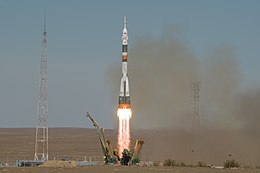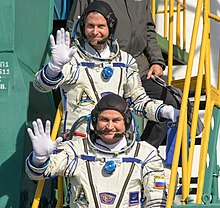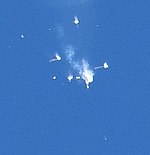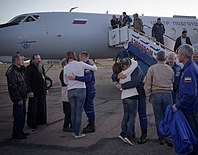Soyuz MS-10
 Launch of the Soyuz-FG rocket carrying the MS-10 spacecraft | |
| Mission type | ISS crew rotation (intended) |
|---|---|
| Operator | Roscosmos |
| Mission duration | 19 minutes, 41 seconds |
| Orbits completed | Failed to orbit |
| Apogee | 93.0 km (sub-orbital spaceflight) |
| Spacecraft properties | |
| Spacecraft type | RKK Energia |
| Crew | |
| Members | |
| Callsign | Burlak |
| Start of mission | |
| Launch date | 11 October 2018, 08:40 UTC |
| Rocket | Soyuz-FG (U15000-064) |
| Launch site | Baikonur Pad 1/5 |
| End of mission | |
| Landing date | 11 October 2018, 08:59 UTC |
| Landing site | 20 km east of Jezkazgan, Kazakhstan |
 Hague (left) and Ovchinin (right) Soyuz programme (Crewed missions) | |
Soyuz MS-10 was a crewed
Crew

| Position | Crew member | |
|---|---|---|
| Commander | RSA Expedition 57 Second spaceflight | |
| Flight Engineer 1 | Expedition 57 First spaceflight | |
| Position[10] | Crew member | |
|---|---|---|
| Commander | RSA
| |
| Flight Engineer 1 | ||
Mission
A few minutes after liftoff, which took place at 08:40 UTC, the crew reported feeling weightless, and mission control declared a booster had failed. According to
Aftermath
Following the aborted spaceflight, the Russian government announced that crewed Soyuz launches would be temporarily suspended. Roscosmos ordered a full state commission to investigate the incident,[18] and the BBC reported that a criminal investigation was also expected.[19] A few weeks prior to the failed launch, another investigation had commenced into how a hole came to be drilled into the wall of the Soyuz MS-09 capsule that was then docked at the International Space Station.[20]
After collecting the debris of the rocket, the Soyuz MS-10 commission started the investigation on 15 October 2018.[21] Initially a faulty cable connecting to the first stage booster was suspected, but by 17 October 2018 the commission was concentrating on the manufacturing sequence of the Soyuz rocket, and set the investigation deadline to 21 October 2018.[22] By 18 October 2018, the failure to correctly mate the first stage booster with the first stage core was identified as the likely cause of the flight abort. The side booster was likely damaged and re-contacted the core during stage separation.[23] On 22 October 2018, the investigation deadline was extended to 30 October 2018, with a preliminary report tentatively blaming a damaged separation sensor failing to activate the separation motor of one of the side boosters, similar to an uncrewed flight failure in 1986.[24] The commission report was provided on 31 October 2018, concluding that a ball joint supporting the errant side booster was deformed during assembly, preventing proper separation of the side booster, while the sensor and separation motor had worked properly.
After the investigation identified an assembly error that would require no material change to the Soyuz-FG configuration, the next crewed Soyuz flight (MS-11) was scheduled for 3 December 2018.[25] Within a day of the incident Dmitry Rogozin, chief of Roscosmos, said that Ovchinin and Hague would fly again in early 2019.[26] In December 2018, it was announced that Ovchinin and Hague would fly on Soyuz MS-12 as part of Expedition 59/60 with Ovchinin serving as Commander of Expedition 60.[27] MS-12 launched successfully on 14 March 2019, achieving the mission that MS-10 had failed.[28]
The MS-10 descent module was installed outside of Roscosmos headquarters. It was unveiled 2 December 2019.[29]
Significant soil pollution by rocket propellants has not been detected at crash sites of the rocket.[30]
See also
References
- ^ NASA (17 September 2018). "Expedition 57". Retrieved 20 September 2018.
- ^ Pietrobon, Steven (5 February 2017). "Russian Launch Manifest". Retrieved 12 February 2017.
- ^ a b Garcia, Mark (11 October 2018). "Crew in Good Condition After Booster Failure". NASA Space Station. Retrieved 11 October 2018.
- ^ Harwood, William (11 October 2018). "Soyuz crew lands safely after emergency launch abort". Spaceflight Now. Retrieved 12 October 2018.
- ^ a b Zak, Anatoly. "Soyuz MS-10 makes emergency landing after a launch failure". RussianSpaceWeb.com. Retrieved 12 October 2018.
- Lyndon B. Johnson Space Center. p. 8. Archived from the original(PDF) on 5 October 2006. Retrieved 20 October 2007.
- ^ Zak, Anatoly. "History of Soyuz Escape System". RussianSpaceWeb.com. Retrieved 12 October 2018.
- ^ Evans, Ben (28 September 2013). "'We Were Swearing!' Thirty Years Since Russia's Brush With Disaster". AmericaSpace.
- ^ Berger, Eric (1 November 2018). "Dramatic footage of Soyuz accident shows rocket booster collision - For the second human launch in a row, there's a likely quality control issue". Ars Technica. Retrieved 1 November 2018.
- ^ Spacefacts.de (20 May 2018). "Manned Spaceflight Launch and Landing Schedule". Retrieved 29 May 2018.
- ^ "Roscosmos reveals cause for Soyuz launch failure". AzerNews. 12 October 2018. Retrieved 14 October 2018.
- ^ Hodge, Nathan; Smith-Spark, Laura (11 October 2018). "Astronauts survive Soyuz rocket emergency landing". CNN. Retrieved 12 October 2018.
- ^ Burghardt, Thomas (18 October 2018). "NASA and Roscosmos trying to avoid an empty Space Station – NASASpaceFlight.com". NASASpaceflight.com. Retrieved 19 October 2018.
- ^ Bridenstine, Jim [@JimBridenstine] (11 October 2018). "@NASA astronaut Nick Hague and Russian cosmonaut Alexey Ovchinin are in good condition following today's aborted launch. I'm grateful that everyone is safe. A thorough investigation into the cause of the incident will be conducted. Full statement below: …" (Tweet) – via Twitter.
anomaly with the booster and the launch ascent was aborted
- ^ NASA Live: Official Stream of NASA TV NASA TV, 11 October 2018.
- ^ Expedition 57 Crew Returns to Baikonur (NHQ201810110007) NASA at Flickr, 11 October 2018.
- ^ @Ruptly (11 October 2018). "*EXCLUSIVE* #SoyuzMS10 crew departs Baikonur for Moscow" (Tweet) – via Twitter.
- ^ "Astronauts escape malfunctioning Soyuz rocket". BBC News. 11 October 2018. Retrieved 11 October 2018.
- ^ "Investigation starts into dramatic Soyuz rocket breakdown". BBC News. 12 October 2018. Retrieved 13 October 2018.
- ^ Sample, Ian (11 October 2018). "Rocket launches to be grounded while mid-air failure is investigated". The Guardian. Retrieved 11 October 2018.
- ^ "Роскосмос. Госкомиссия приступила к работе на РКЦ «Прогресс» 15.10.2018 10:15". Roscosmos.ru. Retrieved 22 October 2018.
- ^ ""Роскосмос" назвал дату готовности доклада об аварии "Союза"" (in Russian). Iz.ru. 17 October 2018. Retrieved 22 October 2018.
- ^ "Эксперты назвали виновных в крушении "Союза МС-10"". Rg.ru. 18 October 2018. Retrieved 22 October 2018.
- ^ СМИ: причиной аварии "Союза" стало повреждение штока между первой и второй ступенями
- ^ "Назначены даты отправки и возвращения с МКС космонавтов после аварии на Байконуре" [Dates assigned for next flights of cosmonauts to and from the ISS after the Baikonur incident] (in Russian). Interfax. 21 October 2018. Retrieved 22 October 2018.
- ^ RT (12 October 2018). "Safe & sound: Soyuz crew returns to Moscow after rocket malfunction" – via YouTube.
- ^ "NASA Astronaut Nick Hague Set for New Space Station Mission After Abort". NASA. 3 December 2018.
- ^ Gebhardt, Chris (14 March 2019). "Soyuz MS-12 docks with the Space Station – NASASpaceFlight.com". NASASpaceflight.com.
- ^ "Soyuz capsule that flew emergency abort lands on display in Moscow". collectSPACE. 4 December 2019. Retrieved 4 December 2019.
- ISSN 0269-7491.
External links
 Media related to Soyuz MS-10 at Wikimedia Commons
Media related to Soyuz MS-10 at Wikimedia Commons Manned Soyuz space mission aborts during launch at Wikinews
Manned Soyuz space mission aborts during launch at Wikinews- Video showing the booster separation





